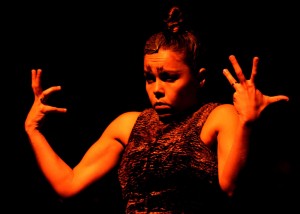By Rachel Straus
Splash. From atop a cantering horse, the avant-garde flamenco artist Rocío Molina plunges into a dark river. This opening film sequence that precedes the live dance work Bosque Ardora (Ardor in the Woods) was seen November 7 at Teatros del Canal—the host of the 2014 Madrid International Dance Festival. Molina’s descent into a dark river is symbolic of her subsequent descent into the underworld of the psyche. There, the thirty-year-old choreographer embodies female archetypes: the goddess (Artemis of the hunt), the vixen (in which she wears a fox mask), and the modern day victim (who is physically punished by high-heel stilettos). Molina never settles too long into one vision, and thus never becomes trapped by female, cultural stereotypes. Molina outfoxes preconceptions: she is a petite, brown-haired beauty; she performs like a chameleon giantess.
The film short at the beginning of the work provides specifics: the woods in twilight, the rush of the hunt, and the violence of a fall. Then the dark river, seen on a proscenium-size screen, is reconstituted and abstracted as the curtain rises: On a black floor bordered by 16 real trees, Molina crouches. Like the fox with long hind legs and a slinking neck that leads its body furtively forward, Molina shape shifts into this animal, and looks out at us from beneath her fox mask with glowing eyes. Some of the trees on stage are hanging upside down, as is the case when seeing a forest’s reflection in water. Molina’s set makes clear that we are in the river with this dancer-choreographer-director. Her artistry is like an under toe. It drags us down and into her dark world.
When Molina exchanges her fox mask and black high priestess dress for a man’s white button down shirt and six-inch, fluorescent yellow heels, it’s as unexpected as the moment when trombonists José Vicente Ortega and Agustín Orozco play jazz and Molina briefly Vogues. In her new costume, which could be called porno executrix, Molina connects with dancer Eduardo Guerrero buttock to groin. He pins her underneath him on the floor, but there is no emotional reaction from either of them. Later Molina in her spikes spins around drunkenly. She is manhandled and she handles this tall, strong man. Their flamenco dancing comes in spurts as if they are finally speaking to each other. Their unemotional sexual acts appear to signify the repressed thoughts of the characters they portray.
Bosque Ardora premiered in Seville in September, and has since toured to France and the U.K. Freud should get a program credit. Molina’s work isn’t linear, or logical. Freud formulated the idea of the ego and the id. In Bosque, Molina is all id (the subconscious): She dances beyond flamenco, or for that matter the safe conventions of most contemporary dance. Whereas in the majority of dance theater works women and men are seen as heroes or cruel victims of tragic fate–or just dancers in space–they are rarely seen as unstable, radioactive figures. Molina is such a dance-actor. One gets the sense that anything is possible when she is on stage.
Throughout the seventy-five minute work, six male musicians loom under the trees. They produce an ever-changing aural landscape that is not only acoustic (birds and liquid vibrations), but also includes instrumentation and song: There is José Angel Carmona’s silvery cante jondo (occasionally accompanied by his electric guitar playing) and the aforementioned trombonists Ortega and Orozco, who dress identically and look like twins. There is also Pablo Martín Jones’s propulsive drumming, on a traditional kit, and his soft finger gliding on golden discs. It’s notable that the guitarist Eduardo Trassierra is the only flamenco traditionalist in the group; and so he sits on a wooden chair as opposed to the other musicians who hover, as if sleepwalking. Though Bosque Adora is far from your typical flamenco show, Molina returns to her Flamenco roots in the finale. With Trassierra as her accompaniment, she becomes the ángel, the gypsy dancer spiritually possessed by her fiery footwork. It’s important to note that the musicians do not play together. Instead they provide highly different landscapes for Molina, and her marvelous male dancers Guerrero and Fernando Jiménez to move through.
Molina has been compared to Pina Bausch, but her work is more in the vein of Martha Graham, especially her Greek period, in which she explored the female psyche and continually casted herself as the Greek goddess, surrounded by strong bare-chested men, who became her erotic architecture. In one section of Molina’s work, the shirtless Guerrero and Jiménez dance on either side of her like twin columns. Their unison footwork is as astonishingly precise as is their concentration on Molina. And this seems right. Molina is the breathtaking one. She directs our eyes on her electrifying footwork, then her snaking buttocks and back, and up to her head, where her changing expressions read like different tragic Greek masks. This profound dancer, who thinks large and moves in dreams that can’t quite be understood, is currently and hauntingly appearing on the world’s stages. She far from a flamenco traditionalist, but she is my kind of goddess.
